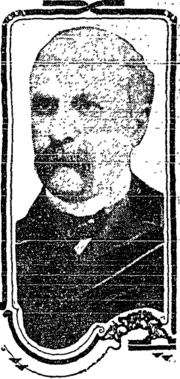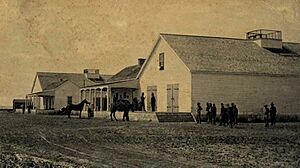Drum Barracks facts for kids
Drum Barracks was a very important place during the American Civil War (1861-1865). It served as the main headquarters for the Union Army in Southern California and New Mexico. Imagine it as a busy military base!
The base had 19 buildings spread across 60 acres in what is now Wilmington, California. There were also another 37 acres of land close to the water. Today, you can visit the old junior officers' quarters, which has been turned into the Drum Barracks Civil War Museum. A special building called the powder magazine, where gunpowder was stored, still stands nearby on private land.
Contents
Why Drum Barracks Was Built
In 1861, a Confederate officer tried to claim parts of Arizona for the Confederacy. The Union Army in California quickly sent troops, known as the California Column, to stop them. This left Southern California with some big problems.
There were three main reasons why Drum Barracks was needed:
- Local Support for the Confederacy: Many people in Southern California, especially in Los Angeles and El Monte, supported the Confederacy. There was a worry they might try to take control of the area. People also feared they might seize gold being mined near San Bernardino and use San Pedro Bay to attack Union ships.
- Native American Conflicts: Native American groups in California and Arizona saw the Civil War as a chance to fight for their lands and resources. This led to more conflicts.
- Threats from Mexico: There was a lot of unrest in Mexico at the time. This made Union leaders worry that Confederate forces might try to attack California by crossing the border from Mexico.
To deal with these threats, the Union Army decided to build a large military base. It was placed next to San Pedro Bay, about 25 miles south of Los Angeles. Troops from Fort Tejon and new recruits were sent to guard the area. The land for the barracks was generously given by two Union supporters, Phineas Banning and Benjamin Wilson. Building the base cost a lot of money, about $1 million!
How Drum Barracks Got Its Name
The Drum Barracks was named after Richard Coulter Drum. He was an important army officer who helped manage the construction of the base from his office in San Francisco. He didn't actually visit the barracks until it was finished in 1863.
Later, in 1863, the commander of the post, Major Bennett, asked if the name could be changed to "Fort Drum." He thought it sounded more like other important forts. However, there's no record of his request ever being answered.
It's interesting to know that there are other places named Fort Drum. For example, Fort Drum in the Philippines was named after Richard C. Drum after he passed away. But Fort Drum, New York, is named after a different general, Hugh A. Drum. And Fort Drum, Florida was named after a post built during an earlier war in 1842.
Dealing with Confederate Supporters
During the Civil War, Union officials were very careful about people who supported the Confederacy. Some important citizens in Los Angeles were even arrested and brought to Drum Barracks.
Henry Hamilton's Arrest
Henry Hamilton, who published a newspaper in Los Angeles, was arrested on October 17, 1862. He was taken to Drum Barracks and then put on a ship to be held at Fort Alcatraz in San Francisco. However, he promised to be loyal to the United States and was back in Los Angeles within two weeks.
The exact reason for his arrest isn't fully known. But he had written many articles that were critical of the Union and supported the Confederate cause.
Undersheriff A.J. King's Arrest
Another person arrested was Undersheriff A.J. King. He was accused of saying he didn't support the U.S. government and that the Confederate government was the only true one. He also publicly displayed a large picture of a Confederate general. Like Hamilton, he took an oath of loyalty to the United States and was released.
Edward J. C. Kewen's Arrest
In October 1862, E.J.C. Kewen, a state assemblyman and former California Attorney General, was arrested for "treasonable utterance." This means he said things that were considered disloyal to the country. He was sent to Fort Alcatraz. After two weeks, he also took an oath of loyalty and was released after paying a $5,000 bond.
One of his speeches, published later, showed his strong feelings against the Union government and its leaders. He questioned why people should be so loyal to President Lincoln and said he didn't like the word "loyalty" because it belonged to kings, not free governments.
Keeping the Peace in Los Angeles
Drum Barracks troops played a big role in preventing trouble in Southern California. Soldiers were often stationed in places like San Bernardino and El Monte.
When Union officials planned to sign up men in Los Angeles for the military draft, some Confederate supporters threatened to cause problems. Two companies of Drum Barracks troops were quickly sent to Los Angeles. They camped outside the town and later moved into the city center to guard important offices. Luckily, California's draft quota was filled by volunteers, so a draft wasn't needed.
In 1863, news of important Union victories at Gettysburg and Vicksburg led to big celebrations. But armed Confederate supporters interrupted these events, and shots were fired. Drum Barracks troops, who were on their way to another mission, stepped in to stop the fighting. More soldiers were later sent to Los Angeles to keep order.
Fighting Native American Groups
When Union troops were moved away from some remote posts, new conflicts with Native American groups began. Soldiers sent east from Los Angeles to fight Confederates often had to fight Native American tribes along the way. These tribes were protecting their lands and water sources.
Some of the battles fought by Los Angeles troops against Native American groups included the Battle of Apache Pass and the Owens Valley Indian War.
Dealing with Threats from Mexico
Mexico was also going through a difficult time with its own wars. In 1862, French troops even got involved in Mexico.
Confederate forces occupied Tucson in 1862. They tried to get supplies from the Mexican state of Sonora. However, Union officials found out about this plan and sent a strong warning to the Mexican governor. They even said Union troops would cross the border if Confederates entered Sonora.
Los Angeles troops, including the Native California Cavalry who spoke Spanish, patrolled the border. They even went into Mexico a few times. For example, in 1862, Captain Fritz chased a group that stole government horses and got them back in Hermosillo, Mexico. The next year, Captain Tuttle caught Confederate supporters who had stolen cattle.
Even after the Civil War ended in 1865, there were still concerns. A rumor spread that a former California Senator was planning a Confederate invasion of California from Mexico. Although this rumor turned out to be false, it shows how worried people were about threats from the south.
Camels at Drum Barracks
Did you know the U.S. Army once tried using camels? From 1862 to 1863, Drum Barracks had corrals (enclosures) for these Army camels. They were brought down from Fort Tejon and later sold at an auction.
After the Civil War
After the Civil War ended, Drum Barracks remained active for a few more years, mainly during conflicts with Native American groups. By 1870, the base was no longer needed and started to fall apart. In 1871, the remaining troops were sent to Fort Yuma.
In 1873, the government gave the land back to the original donors, Phineas Banning and Benjamin Davis Wilson. The buildings were put up for auction. Since buyers would have to move or take apart the buildings, there weren't many bids. Banning bought five buildings for $2,917, and Wilson bought one for $200.
Ghost Stories
The Drum Barracks Civil War Museum is known for its ghost stories! The Los Angeles Times newspaper wrote about the museum's "resident ghosts" in 1992. One story mentioned a ghost who "doesn't know he's dead."
The barracks was also featured on TV shows like Unsolved Mysteries in the early 1990s. People interviewed on the show described seeing ghosts of Civil War soldiers. It was also shown on an episode of Most Haunted in 2005.
Historical Recognition
Drum Barracks has been recognized as an important historical site:
- California Historical Landmark #169, listed in 1935
- Los Angeles Historic-Cultural Monument #21, listed in 1963
- National Register Of Historic Places, listed in 1971
Since 1987, Drum Barracks has been open to the public as a Civil War museum.






